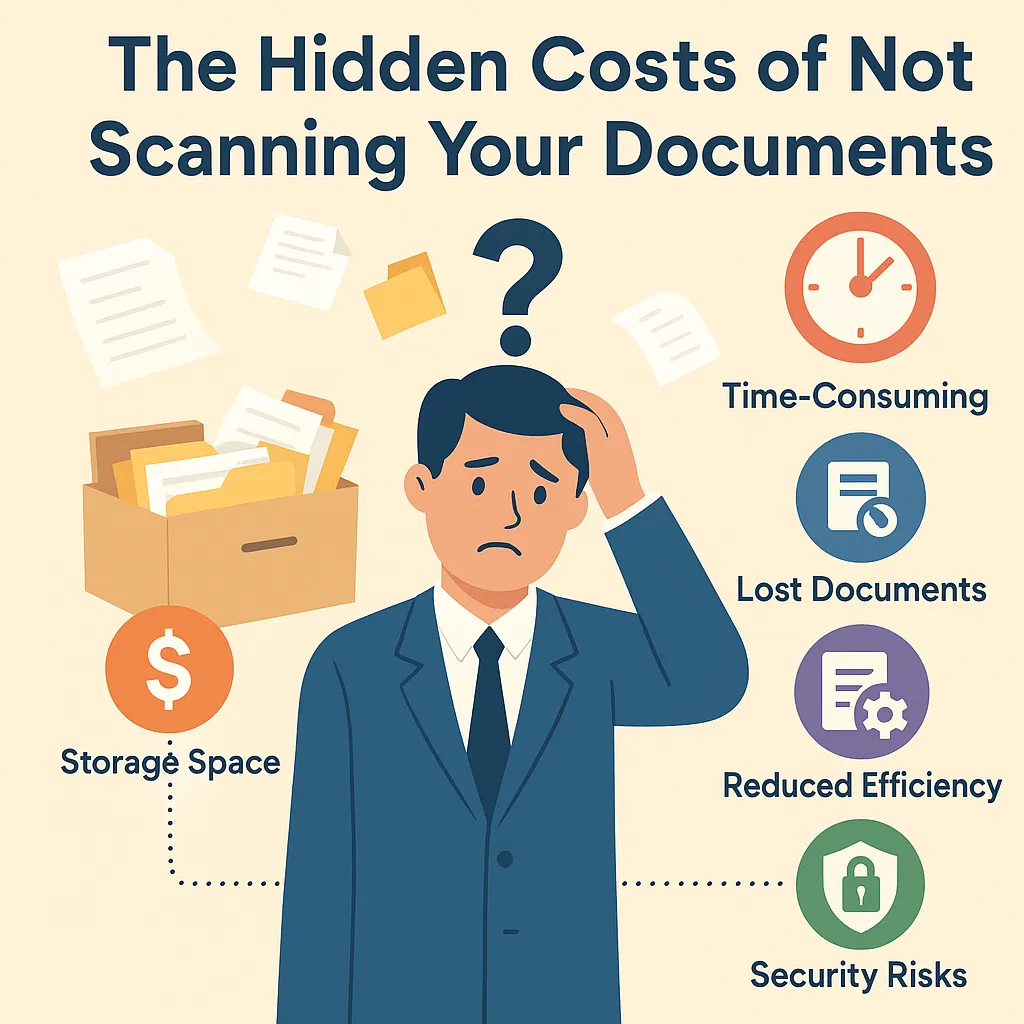
The Price of Paper: The Hidden Costs of Not Scanning Your Documents
By: USA IMAGING, Inc.
For many businesses, schools, and government offices, paper is still king. Filing cabinets, storage rooms, and even off-site warehouses are filled with boxes of documents that must be stored for years—sometimes decades.
At first glance, keeping everything in paper form might seem inexpensive. After all, paper is “already there” and filing cabinets don’t require much more than some office space. But here’s the truth: not scanning your documents is costing you far more than you realize. The expenses are often hidden—spread across time, productivity, compliance risks, and even lost opportunities.
Let’s pull back the curtain and explore why sticking with paper could be draining your organization more than you think.
1. Lost Time = Lost Money
Think about how often staff need to retrieve documents. With paper, this means:
Walking to a filing room
Digging through boxes or cabinets
Sifting through folders for the right file
Re-filing everything
It doesn’t sound like much, but studies have shown that the average worker spends 20–30% of their time searching for information. That’s nearly a third of their workday lost to something that could be solved in seconds with a digital search.
Multiply those hours across your staff, and you’ll see how much money is wasted each month on something as simple as looking for files.
2. Storage Costs Keep Rising
One filing cabinet takes up about 15 square feet of space. If you’re in an office where rent costs $2 per square foot, that one cabinet costs you $30 a month just to sit there.
Now, imagine an entire room—or warehouse—dedicated to storing paper. Those costs add up fast. Even off-site storage isn’t cheap. Many companies pay thousands every year for record storage facilities. And when you need a file, there are retrieval fees on top of it.
Scanning documents drastically reduces or eliminates this expense by moving your records into compact, searchable digital archives.
3. Compliance Risks and Legal Costs
Industries like healthcare, law, and education have strict regulations about how records are maintained. Keeping only paper files makes it harder to:
Track who accessed a record
Restrict access to sensitive information
Prove compliance during an audit
If a regulator finds you out of compliance—or worse, if sensitive information is lost or stolen—the fines and legal costs can be staggering. Digitized documents, on the other hand, can be encrypted, password-protected, and tracked with audit trails.
4. The Risk of Disaster
What happens if your building floods, there’s a fire, or pests destroy a box of files? Paper doesn’t last forever, and once it’s gone, it’s gone for good.
Digitized records can be backed up in multiple locations and secured in the cloud. Even in the event of a natural disaster, your files remain safe and accessible.
5. Productivity Bottlenecks
When files are stuck in paper form, collaboration suffers. Staff in different departments—or different buildings—can’t access them at the same time. That means delays, duplicate efforts, and frustration.
Digital scanning eliminates bottlenecks. Multiple staff members can access the same document simultaneously, from anywhere. This is especially critical for remote and hybrid teams.
6. The Cost of Errors
Paper is prone to misfiling. A single misplaced document can take hours—or even days—to locate. In some cases, it may never be found. The result? Missed deadlines, lost revenue, and unhappy clients.
Digital indexing and search functions ensure files are where they should be, and that they can always be found.
7. Lost Opportunities
Here’s the part most people don’t consider: not scanning your documents means missing out on better opportunities.
Digitized files can integrate with workflow automation, customer management software, and data analytics tools. Paper can’t. By sticking with paper, your business misses the chance to work smarter, streamline processes, and stay ahead of the competition.
A Real-World Example
A mid-sized law firm we worked with had 25 years of case files stored in cabinets and off-site warehouses. Staff often spent hours pulling files for active cases, and off-site requests sometimes took days.
After digitizing with USA IMAGING, Inc., attorneys could pull case files instantly, even from the courtroom. The firm also eliminated two entire storage units, saving over $20,000 a year in storage costs. And because files were now indexed and searchable, attorneys could prepare cases more efficiently—giving them an edge in court.
The True Cost of “Doing Nothing”
When you add it all up, the cost of not scanning your documents includes:
Staff time wasted searching for files
Rising storage expenses
Compliance and legal risks
Potential losses from disasters
Productivity slowdowns
Missed opportunities for efficiency and growth
The reality is, scanning your documents isn’t just an upgrade—it’s an investment. And in most cases, the cost of scanning pays for itself many times over.
Final Thought
Paper might feel familiar, but in today’s fast-moving world, it’s holding you back. Digital scanning offers a safer, faster, and more cost-effective way to manage your records—while protecting your organization from risks you might not even see coming.
If your business is still buried in paper, it’s time to take a closer look at the hidden costs.
📞 Contact Us: 858-513-6565
📩 Request a Quote: Click Here
